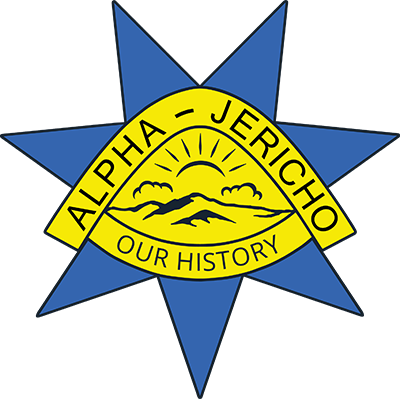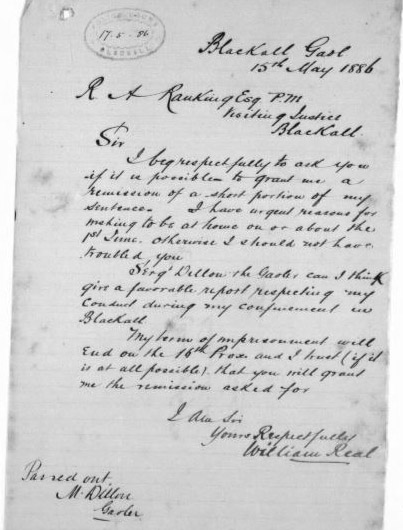In March 1886, fifty men from the Blackall district, twenty-eight of whom were residents of Jericho, presented a petition, supporting William Real during his imprisonment in Blackall Gaol. He had been charged with two offences – forgery and uttering, also larceny and receiving. The petition supported William Real’s request to be released from the final two weeks of a six-month sentence. He was released but perhaps not before the date he stated as urgent – 1st June.[1]
The residents signing the petition demonstrated their concern for William Real on a number of counts, among which were that the prisoner had lost evidence central to his defence in a fire at his Pine Hill office; that the Jericho Police Magistrate, without reason, refused to offer bail and that the prisoner had a wife and young children to support. However there is more to the story of William Real’s time along the railway line than this trial and imprisonment.
Before arriving in the district, William Real, a 22-year old from Ireland had established the head office of the newly formed Central Queensland Carriers’ Association at Bogantungan, the terminus of the central Queensland railway line from 1881 to 1883.[2] In this role he acted as agent for members of the Association in the despatch of goods from the railway to the carrier’s wagons on their way to the rural station owners and storekeepers in rural towns. However nine months later, July 1883, it was advised through the newspapers that he would no longer have any connection with the Carriers Association. The only suggestion presented for his dismissal as agent was that he ‘had a row’ with the manager of the Association, Michael H Roberts.[3]
By this time William Real had been granted an Auctioneers Licence. His partnership with Richard Magill as Forwarding and Commission Agents and Auctioneers was soon dissolved by mutual consent to be carried on by William Real alone.
William Real moved, with his wife Georgina and two children to Pine Hill, the next terminus. There he carried on his Agency and operated as attorney for several men in the Small Debts Court. On a number of occasions in 1885, he attended the Court on his own behalf seeking money he was owed for goods, for work performed or cash lent. He was also in Court himself defending a charge of having sold by public auction without a licence. He was fined the minimum £15. However, details of the case caused the Police Magistrate to represent the case to the Colonial Secretary in an effort to reduce the fine.[4] The result of this plea is unknown.
Fire was an enemy for him – in June 1884 a fire burnt a two-storey building to the ground with all contents. William Real was one of the three tenants. He reported his uninsured loss as £200. Ten months later fire again destroyed his office. On this occasion seven local men petitioned for an enquiry to be held – suspicion had been raised about Frank Lee Morris, a competitor as auctioneer, in causing the fire. However the inquest held locally into the fire did not result in a decision and the depositions ordered sent to the Attorney General.[5]
When the opportunity came up for William Real to purchase, on 26 May 1885, town lots at Jericho, the next terminus, he purchased five allotments, one as an agent for another purchaser. The family had moved by August when William joined a committee seeking a provisional school for the children of the emerging town. By now his eldest son was ready to attend. By September, he had established an office, in which a marriage was performed.
However he soon found himself in Court again, this time defending the two cases that led to his imprisonment in Blackall. They resulted from an arrangement he had drawn up in February 1884 with John Younger, a carrier. While the carrier was absent for months on a carrying trip, William Real forged John Younger’s endorsement of a Draft the carrier had received from Scotland (£23/14/4). William Real’s defence was that the arrangement had allowed him to take money that he was owed from the value of the Draft. The fire in Pine Hill had destroyed the evidence. William Real was found guilty and, with mercy granted on account of his wife and family, imprisoned to six months on each charge to be served concurrently.[6]
Most of the 28 men who signed the petition in Jericho were business men, the overwhelming number of whom were also moving from terminus to terminus along the line, so would have known William Real for some years. Just a few were public servants, a few others carriers, possibly his clients. The petitioners’ statements on the petition show that support for this complex man was based on a numbers of reasons – lack of producible evidence, police responses and personal and family concerns.
After his imprisonment, William Real returned to Jericho and moved on to Barcaldine a year later. His experiences in central-western Queensland are only a part of his life as he soon moved to north Queensland, finally to Cairns. There he adopted a career as newspaper correspondent and editor of the Cairns Post. After his death on 15 July 1912, he was noted as an ‘able journalist [who] did much to advocate the potentialities of North Queensland’.[7] Accounts of his life do not mention the time he spent in central-western Queensland, except that The Western Champion noted that he had been a reporter for it 25 years previously.[8]
[1] Petition and Court papers, Colonial Secretary’s Correspondence, File 86/3989, ID847197, Queensland State Archives (QSA).
[2] The Capricornian, 30 September 1882, p. 21.
[3] Morning Bulletin, 13 July 1883, p. 1; Queensland Figaro, 8 September 1883, p. 11.
[4] Morning Bulletin, 30 January 1885, p. 5 and 24 Mar 1884, p. 3; Record Book, Pine Hill/Barcaldine, Item ID 278089, QSA.
[5] Morning Bulletin, 23 June 1884, p. 2; Arson, Queensland Police Gazette, 14 April, 1885, p. 118; Pine Hill fire, Inquest 171, Item ID 348716, QSA.
[6] Court of Petty Sessions, Jericho, Register depositions, 1885-1888, Item ID 296283, QSA; Morning Bulletin, 28 December 1885, p. 4.
[7] Townsville Daily Bulletin, 20 July 1912, p. 4.
[8] Western Champion. 20 July 1912, p. 12.
< Go Back
